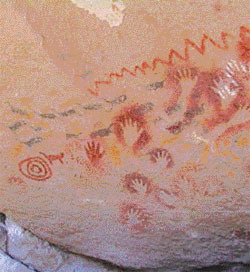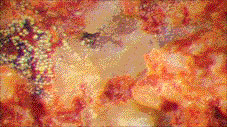|
Ancient rock art's colours come from microbes
A particular type of ancient rock art in Western Australia maintains
its vivid colours because it is alive, researchers have found. While
some rock art fades in hundreds of years, the "Bradshaw art" remains
colourful after at least 40,000 years.
  Jack
Pettigrew of the University of Queensland in Australia has shown that
the paintings have been colonised by colourful bacteria and fungi. Jack
Pettigrew of the University of Queensland in Australia has shown that
the paintings have been colonised by colourful bacteria and fungi.
These "biofilms" may explain previous difficulties in dating such
rock art.
Professor Pettigrew and his colleagues studied 80 of these Bradshaw
rock artworks - named for the 19th-Century naturalist who first
identified them - in 16 locations within Western Australia's Kimberley
region.
They concentrated on two of the oldest known styles of Bradshaw art -
Tassel and Sash - and found that a vast majority of them showed signs of
life, but no paint.The team dubbed the phenomenon "Living pigments".
"'Living pigments' is a metaphorical (figurative) device to refer to
the fact that the pigments of the original paint have been replaced by
pigmented micro-organisms," Professor Pettigrew told BBC News.
"These organisms are alive and could have replenished themselves over
endless millennia to explain the freshness of the paintings'
appearance."
Among the most frequent inhabitants of the boundaries of the artwork
was a black fungus, thought to be of the group of fungi known as
Chaetothyriales.
 Successive
generations of these fungi grow by cannibalising (eating their own kind)
their predecessors. That means that if the initial paint layer - from
tens of thousands of years ago - had spores of the fungus within it, the
current fungal inhabitants may be direct descendants. Successive
generations of these fungi grow by cannibalising (eating their own kind)
their predecessors. That means that if the initial paint layer - from
tens of thousands of years ago - had spores of the fungus within it, the
current fungal inhabitants may be direct descendants.
The team also noted that the original paint may have had nutrients in
it that "kick-started" a mutual relationship between the black fungi and
red bacteria that often appear together. The fungi can provide water to
the bacteria, while the bacteria provide carbohydrates to the fungi.
The exact species involved in these colourations have yet to be
identified, and Professor Pettigrew said that the harsh conditions in
the Kimberley region may hamper future research.
However, even the suggestion of these "living pigments" may explain
why attempts to date some rock art has shown inconsistent results:
although the paintings may be ancient, the life that fills their
outlines is quite recent."Dating individual Bradshaw art is crucial to
any further understanding of its meaning and development," Professor
Pettigrew said.
"That possibility is presently far away, but the biofilm offers a
possible avenue using DNA sequence evolution. We have begun work on that
but this will be a long project."
Courtesy: BBC |

